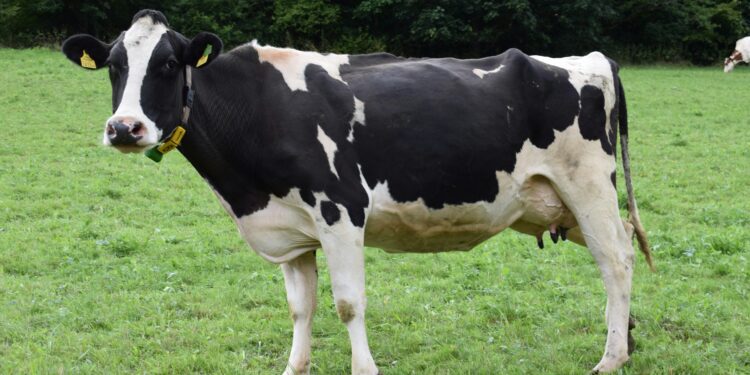Milk Under Quarantine
Warm forage rarely figures in national conversation; nonetheless, by early July the smell of barn ventilation fans had drifted into Twitter threads and supermarket rumors. According to the Centers for Disease Control and Prevention’s situation summary, 1,074 dairy herds in seventeen states are now confirmed carriers of highly pathogenic avian influenza A(H5N1). The agency still regards population-wide risk as low, yet that reassurance collides daily with photographs of quarantined parlors and goggles on milking crews.
A Concise Epidemiological Ledger
Genetically, H5N1 has circulated among wild birds since the late 1990s; its arrival in Bos taurus is novel. The CDC’s current “dairy mammals” page records the inaugural bovine detection on 25 March 2024. From there the virus crept outward—Texas Panhandle, Idaho’s Snake River Plain, California’s Central Valley, then north and east through the Midwest.
Human infection remains exceptional yet no longer theoretical. On 1 April 2024 the CDC confirmed conjunctivitis in a Texas dairy employee. A detailed clinical note, published shortly after in CIDRAP’s bulletin, linked the case to direct contact with symptomatic cattle and described viral RNA limited to ocular tissue rather than nasopharyngeal swabs (https://www.cidrap.umn.edu/avian-influenza-bird-flu/case-report-bolsters-evidence-h5n1-avian-flu-spread-cow-texas-dairy-worker). Subsequent single-patient reports in Michigan and Colorado echoed the pattern: redness, mild discomfort, positive polymerase chain reaction, no pneumonia.
The Risk-Communication Tightrope
Virology provides data; perception translates data into behavior. In June, “bird-flu milk” climbed into TikTok trend lists, propelled by recycled clips of frothy glasses and alarming captions. Raw-milk enthusiasts quickly blamed “industrial confinement,” ignoring evidence that the same virus circulates in free-range herds. State officials rebutted on their dashboards, yet dashboards never match the velocity of viral video.
Laboratory results support the regulators: the Food and Drug Administration sampled 464 pasteurized products ranging from whole milk to ice cream and detected no viable virus. Pasteurization at 161 °F for fifteen seconds remains a formidable firewall. Nevertheless, markets price impressions as readily as bacteria. A January Reuters commodities note reported an eight-percent retail milk rise after analysts incorporated California supply disruptions into their models (https://www.reuters.com/markets/us/trump-tariffs-stoke-us-food-inflation-despite-pledge-lower-costs-2025-01-31/).
California: Epicenter and Warning Signal
California—guardian of roughly one-seventh of national dairy volume—illustrates the outbreak’s production toll. The California Department of Food and Agriculture posts weekly ledgers listing both newly quarantined and newly released herds; the 24 April 2025 bulletin recorded 613 dairies coming off quarantine and one fresh herd entering it (https://www.cdfa.ca.gov/AHFSS/Animal_Health/HPAI.html). Herd recovery is encouraging; chronic churn signals viral persistence.
Bio-risk scientists at Colorado State University characterize the event as a “cross-species spillover of consequence,” noting that mammalian replication widens the evolutionary laboratory available to the virus (https://cvmbs.source.colostate.edu/stat-news-as-bird-flu-spreads-among-u-s-cattle-veterinarians-find-themselves-in-a-familiar-position-the-frontlines/). Their phrasing is restrained; nevertheless, the implication is clear: each week the virus spends in cattle grants additional mutation opportunities.
Is the Virus Rewriting Biosecurity or Merely Revealing Its Gaps?
Federal guidance recommends twice-daily symptom audits and immediate segregation of cows with reduced yield or ocular discharge, yet enforcement resides mainly in state bureaus. Portable PCR units and RFID collars exist, but they are unevenly distributed outside vertically integrated mega-dairies. The USDA’s National Milk Testing Strategy seeks to standardize sampling, though participation remains voluntary in several regions.
Meanwhile, controlled studies continue to show that pasteurization destroys infectivity; raw milk from symptomatic cows carries detectable RNA, not necessarily viable virions. The firewall functions downstream. Upstream, aerosol exposure in enclosed barns persists; goggles and change-out coveralls mitigate, yet compliance fluctuates with labor pressures.
The Cultural Narrative Emerges
Science alone seldom satisfies public anxiety. The Verge recently labeled the protracted fight a “forever war with bird flu”, underscoring the sense of interminable vigilance. Social trust shapes outcomes: research on risk perception repeatedly finds that when institutional voices appear fragmented, audiences fill the vacuum with conjecture.
Recent joint statements by the International Dairy Foods Association reiterate the safety of pasteurized products, yet also acknowledge the communicative gulf separating industry fact-sheets from consumer feeds. That gulf widens whenever new state quarantines surface without context, or when user-generated footage shows carcasses awaiting rendering under Central Valley heat (https://www.reuters.com/world/us/cows-dead-bird-flu-rot-california-heat-bakes-dairy-farms-2024-10-17/).
Economics of Uncertainty
Agricultural economists often quip that “markets detest ambiguity.” Milk futures during the first quarter of 2025 mirrored every fresh quarantine notice, dipping on containment optimism and climbing on new state detections. The pattern resembles prior zoonotic episodes—mad-cow in 2003, swine flu in 2009—yet dairy’s ubiquity magnifies the feedback loop: a household can forego steak for weeks, but morning coffee seldom skips milk.
Variation is already visible. Retail data aggregator Ever.Ag, spotlighted in the Dairy Bar newsletter (April 2025 issue), showed oat-drink sales up twelve percent week-over-week after the March H5N1 headlines, while conventional milk volumes slipped three percent. The shift is modest, but supply chains running on slim margins feel small tremors quickly.
Political Contours
Hearings scheduled for early autumn will reopen debates about permanent funding for the National Animal Health Laboratory Network and the merits of a federal vaccination mandate for cattle. Large-scale producers argue that indemnities must accompany any mandatory program; smaller operations fear disproportionate compliance costs. Worker advocates remind legislators that occupational safeguards without wage buffers merely shift epidemiological risk onto employees.
Where Public Perception Meets Personal Choice
In grocery aisles from Boise to Baton Rouge, QR-coded “farm-of-origin” stickers now compete with organic seals for attention. Small surveys conducted by university extension programs indicate that most consumers continue purchasing pasteurized milk; however, a vocal minority has pivoted toward plant alternatives citing “flu concern.” Whether that migration persists will depend on regulatory clarity, outbreak trajectory, and the narrative architecture built by media outlets.
Japan’s decisive response to its 2010 foot-and-mouth outbreak—rapid culling with full compensation—often appears in policy discussions, yet virological and economic contexts differ. The United States has chosen a containment strategy reliant on movement restrictions and staged quarantine release rather than blanket depopulation. Success hinges on timely diagnostics and transparent reporting.
The Road Ahead
Two questions dominate virology colloquia. First, will H5N1 acquire efficient mammal-to-mammal transmission that extends beyond confined workplaces. Second, can surveillance detect that shift quickly enough to brace public-health systems. The answer to both rests on the same infrastructure now under scrutiny: laboratory throughput, data sharing, and institutional credibility.
For the moment, pasteurized milk remains safe; grocery distribution continues; the CDC’s risk assessment for the general population stays at “low.” Yet the escalating herd count reshapes the public’s mental map of food safety. Where consumers once pictured pasture and parlor, they now envision polymerase enzymes and phylogenetic trees.
The dairy crisis has therefore moved beyond a veterinarian’s spreadsheet; it has become a cultural narrative unfolding in real time. Viruses travel according to molecular biology; confidence travels according to collective imagination. Re-aligning those trajectories will test government, industry, and science long after the final quarantine placard is folded and stored.















